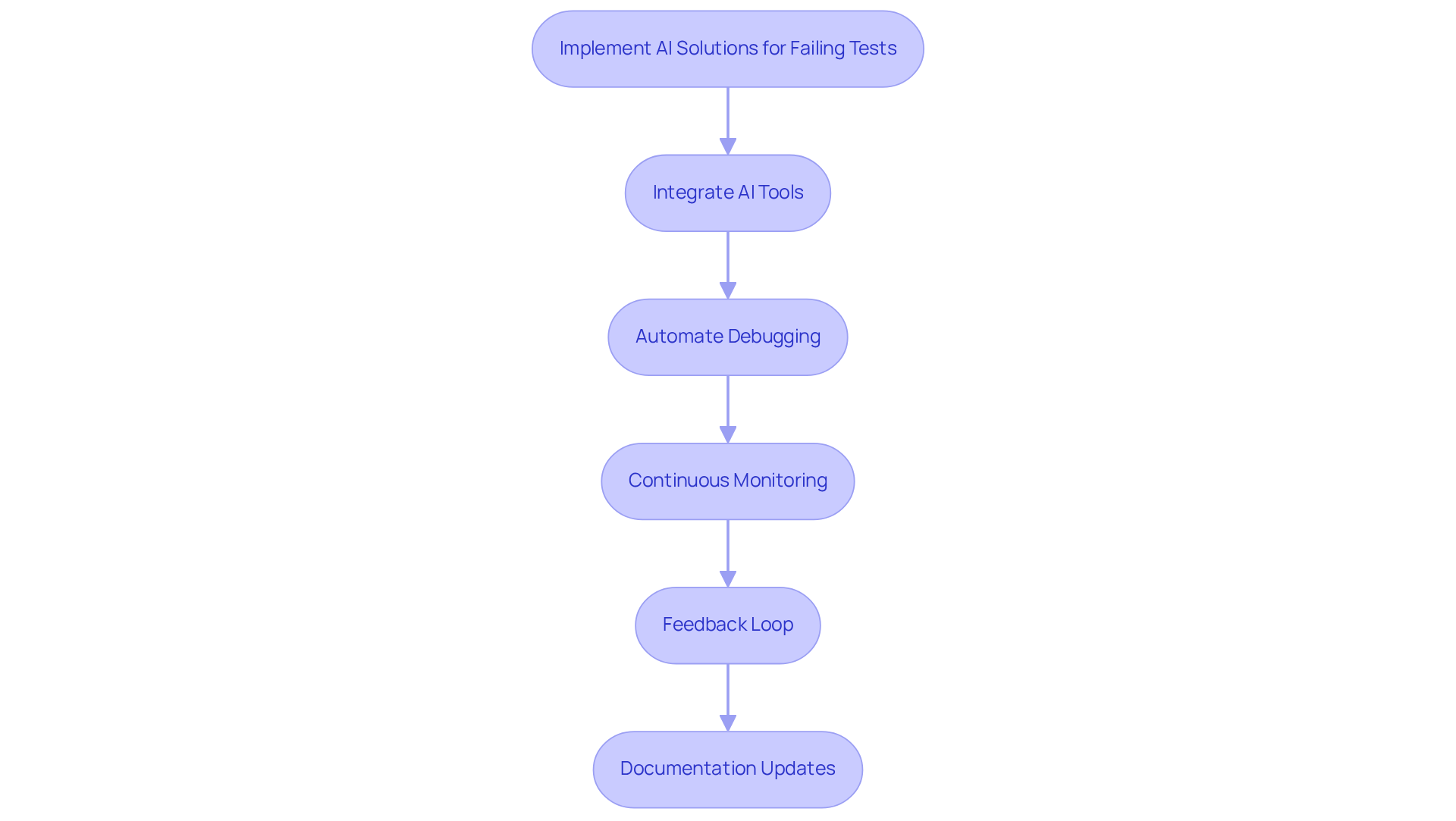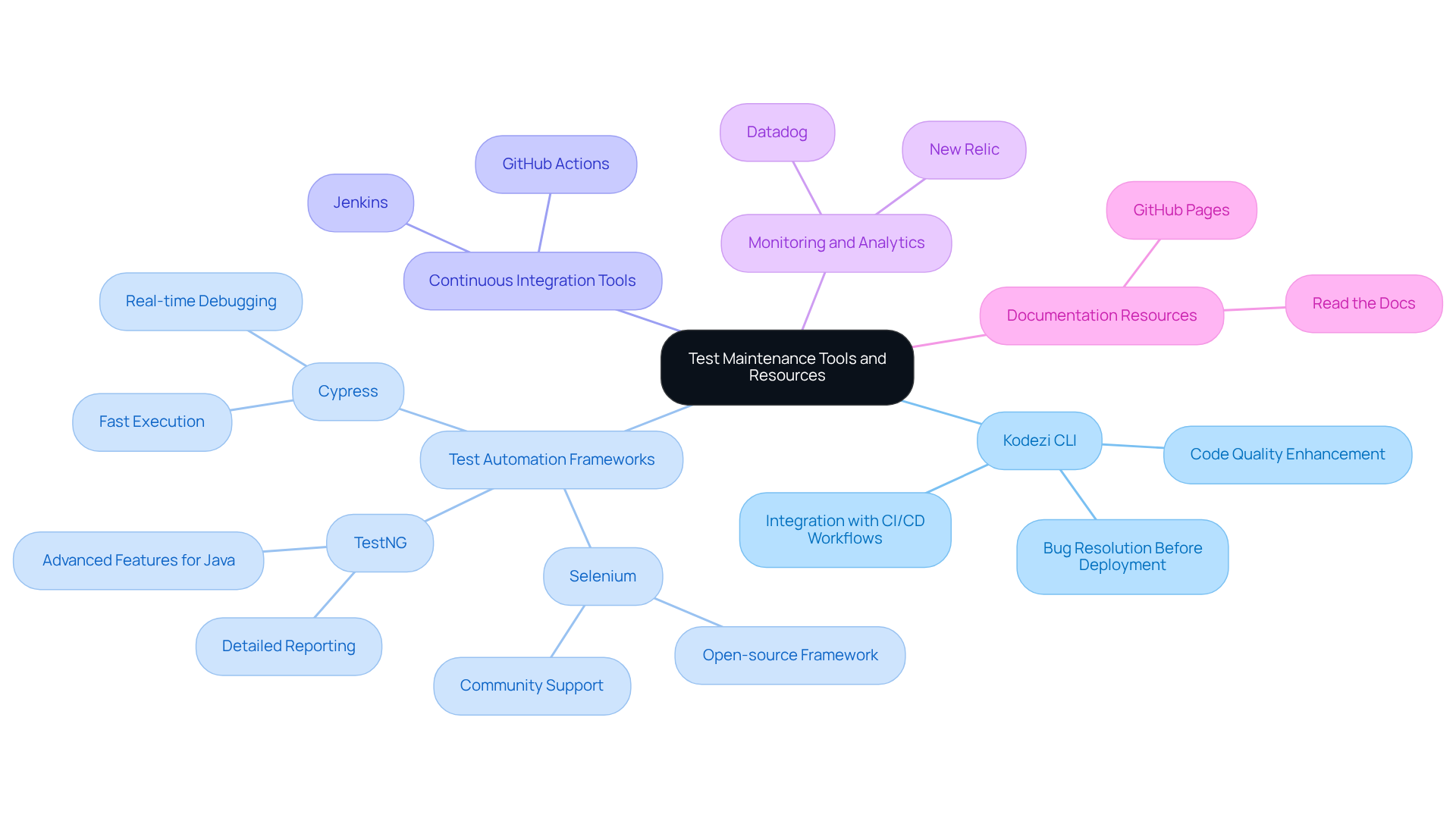Introduction
The landscape of software development is increasingly complex, and coding challenges often lead to significant delays and frustration for developers. As the demand for reliable applications grows, the importance of automated testing becomes paramount. How can developers navigate these challenges effectively? This is where Kodezi OS steps in, revolutionizing code maintenance by utilizing AI to fix failing tests, streamline debugging processes, and enhance overall software quality.
Imagine a scenario where traditional testing methods fall short. Developers are left grappling with issues that could have been resolved swiftly. Kodezi addresses these pain points by offering features that not only automate testing but also provide real-time feedback on code quality. Furthermore, the platform's AI capabilities ensure that developers can focus on what truly matters—building robust applications.
The benefits of using Kodezi are clear:
- Improved productivity
- Reduced frustration
- Enhanced code quality
By integrating Kodezi into your workflow, you can transform the way you approach software development. So, why not explore the tools available on the platform and see how they can elevate your coding practices? With Kodezi, you’re not just fixing problems; you’re paving the way for a more efficient development process.
Understand the Importance of Automated Testing
Coding challenges can be daunting for developers, often leading to delays and frustration. Automated evaluation is essential in software development, significantly enhancing the reliability and functionality of applications. Kodezi addresses these challenges by allowing developers to execute evaluations automatically, speeding up the assessment process and reducing human mistakes.
By utilizing automated tests, particularly with tools like Kodezi CLI, teams can quickly detect bugs and regressions, allowing AI to fix failing tests to be implemented effectively. This ensures that new changes don’t interfere with existing functionality. Isn’t it better to catch issues early? This proactive approach is crucial, as fixing bugs during development is far less costly than addressing them in production.
Furthermore, Kodezi CLI independently enhances quality by immediately recognizing and correcting codebase problems. It offers comprehensive explanations and insights into what occurred and how it was addressed. In addition, automated evaluation seamlessly integrates with continuous integration and delivery (CI/CD) practices, empowering teams to deploy updates more frequently and with greater confidence.
For example, automated regression evaluation guarantees that recent code modifications do not jeopardize existing functionalities. It enhances coverage by executing thousands of assessments, including edge cases, in a shorter timeframe. The process is enhanced as the AI fixes failing tests through automated builds and evaluations, ensuring adherence to the latest security best practices and coding standards while addressing performance bottlenecks.
Automated evaluation scales effortlessly with application expansion, maintaining high coverage without rising labor expenses. As a result, teams can maintain high-quality standards while scaling their applications efficiently. Adopting automated testing, especially via tools like Kodezi CLI, is an essential measure for enhancing maintenance practices and attaining lasting success in software development. Why not explore the tools available on the Kodezi platform today?

Identify Common Causes of Failing Tests
Coding challenges can be a real headache for developers, especially when they need to ai fix failing tests. These failures often stem from various issues that can disrupt the development process, prompting the need to ai fix failing tests.
Flaky tests are one common culprit that AI can fix failing tests. They produce inconsistent results due to timing issues or dependencies on external systems. Kodezi can assist in recognizing and rectifying these inconsistencies by utilizing ai fix failing tests to automatically examine and troubleshoot the programming.
Another issue is Outdated Test Cases. When tests don’t reflect the current state of the application, often due to changes in functionality or requirements, ai fix failing tests can address these issues and prevent significant setbacks. Kodezi enhances and refreshes programming, using ai fix failing tests to ensure that examination scenarios remain pertinent and efficient.
Then there’s Insufficient Test Coverage. Areas of the code that aren’t adequately tested can lead to undetected bugs, and this is where ai fix failing tests can be beneficial. Kodezi boosts efficiency by automatically creating comments and documentation, which assists developers as they ai fix failing tests and enhance their test coverage.
Environmental Issues also play a role. Differences between the testing environment and production can lead to unexpected evaluation failures, but ai fix failing tests can help resolve these issues. Kodezi’s AI engine operates in the browser and employs features to ai fix failing tests, ensuring that programming and data are safeguarded while providing insights into environmental discrepancies.
Lastly, Program Modifications can introduce bugs or alter existing functionality, which is where ai fix failing tests can help prevent evaluation failures. Kodezi aims to function as an autocorrect for code, enabling ai to fix failing tests by automatically debugging and resolving coding problems, which helps maintain the integrity of assessments.
By recognizing these frequent factors and utilizing Kodezi’s features, teams can take proactive measures to ai fix failing tests. This ensures that evaluations remain dependable, ultimately improving productivity and code quality. Why not explore the tools available on Kodezi and see how they can transform your coding experience?

Implement AI Solutions to Fix Failing Tests
Coding challenges can be daunting for developers, especially when they rely on AI to fix failing tests unexpectedly. Fortunately, AI solutions like Kodezi OS are here to help. By integrating AI-driven evaluation tools, teams can utilize AI to fix failing tests to automatically assess failures and propose corrections, learning from past evaluations to enhance precision and efficiency over time.
-
Integrate AI Tools: Kodezi OS stands out by utilizing AI-driven evaluation solutions that automatically assess failures and suggest corrections. These tools consistently learn from previous evaluations, improving their precision and efficiency over time.
-
Automate Debugging: Imagine having an AI tool that independently performs diagnostics on unsuccessful evaluations. This proactive approach identifies root causes and suggests practical solutions to AI to fix failing tests, minimizing downtime and accelerating the debugging process.
-
Continuous Monitoring: Furthermore, Kodezi ensures that your AI solution consistently observes the codebase for changes that may affect evaluation results. This capability allows for real-time adjustments, maintaining the integrity of your testing framework.
-
Feedback Loop: In addition, establishing a feedback mechanism where the AI tool learns from manual fixes applied by developers can help the AI fix failing tests and improve its future suggestions. This iterative learning process makes the tool progressively effective in addressing failures.
-
Documentation Updates: Similarly, Kodezi can automatically refresh documentation related to assessments and code changes. This ensures that all team members are informed of the latest developments, fostering better collaboration and understanding.
By applying these AI solutions, teams can greatly minimize the time and effort needed to manage their evaluation suites. This ultimately leads to improved software quality and reliability. Why not explore the tools available on the Kodezi platform today?

Explore Additional Tools and Resources for Test Maintenance
Coding challenges can be daunting for developers, often leading to frustration and inefficiencies. To tackle these issues head-on, consider exploring tools and resources that can ai fix failing tests and significantly enhance your test maintenance efforts.
Kodezi Command Line Interface stands out as a self-sufficient solution designed specifically for B2B engineering teams. It enhances code quality and resolves bugs before deployment. The CLI autonomously analyzes your codebase, identifies potential issues, and implements fixes, ensuring a smoother development process. By incorporating the CLI into your CI/CD workflows, you can simplify your assessment procedures and elevate your programming skills. Plus, Kodezi offers a quickstart guide and demo options to help teams get started quickly and effectively.
In addition to Kodezi, Test Automation Frameworks like Selenium, Cypress, and TestNG can assist in automating your evaluation processes, making management and execution a breeze.
Furthermore, consider tools like Mabl and Testim that utilize ai fix failing tests for better evaluation. These solutions provide AI features that help identify unreliable assessments and automate corrections, enabling you to ai fix failing tests and streamline your testing efforts.
Integrating Continuous Integration Tools like Jenkins or GitHub Actions can also automate the testing process as part of your deployment pipeline, ensuring that your code is always in top shape.
To keep an eye on application performance, utilize Monitoring and Analytics tools like New Relic or Datadog. These platforms help pinpoint areas where assessments may be failing due to environmental issues.
Lastly, don’t overlook the importance of Documentation Resources. Platforms like Read the Docs or GitHub Pages can help you maintain up-to-date documentation for your tests and codebase.
By leveraging these tools and resources, including the Kodezi CLI, teams can create a more efficient and effective testing environment. Why not take the first step towards enhancing your coding practices today?

Conclusion
In today's fast-paced software development landscape, developers often grapple with numerous coding challenges. Embracing automated testing, particularly through innovative tools like Kodezi OS, is crucial for overcoming these hurdles. This approach not only streamlines code maintenance but also significantly enhances the reliability and efficiency of applications. By automating the evaluation process, developers can proactively identify and rectify issues, ensuring that new changes do not compromise existing functionalities.
So, how does Kodezi address these challenges? The article highlights several key aspects of automated testing, including:
- The identification of common causes of failing tests
- The integration of AI solutions
- The importance of maintaining updated documentation
Tools such as Kodezi CLI empower teams to automate debugging, continuously monitor codebases, and implement effective feedback loops. These features contribute to a more robust development process, making it easier for teams to stay on top of their projects.
What are the benefits of using Kodezi? Leveraging other automation frameworks and resources can further enhance testing practices and overall software quality. Ultimately, the significance of adopting automated testing tools cannot be overstated. As development environments grow more complex, the need for reliable and efficient testing solutions becomes paramount. By exploring and integrating these advanced tools, teams can not only improve their coding practices but also foster a culture of continuous improvement and innovation.
Are you ready to take action? Taking steps now can lead to lasting success in the ever-evolving landscape of software development. Explore the tools available on the Kodezi platform and see how they can transform your coding experience.
Frequently Asked Questions
What is the importance of automated testing in software development?
Automated testing enhances the reliability and functionality of applications by allowing developers to execute evaluations automatically, speeding up the assessment process and reducing human mistakes.
How does Kodezi help with automated testing?
Kodezi enables developers to automatically evaluate their code, quickly detect bugs and regressions, and fix failing tests effectively, ensuring that new changes do not interfere with existing functionality.
Why is it better to catch bugs early in the development process?
Catching issues early is crucial because fixing bugs during development is far less costly than addressing them in production.
What additional benefits does Kodezi CLI provide?
Kodezi CLI enhances quality by recognizing and correcting codebase problems immediately, providing comprehensive explanations and insights into the issues encountered and how they were resolved.
How does automated evaluation integrate with CI/CD practices?
Automated evaluation seamlessly integrates with continuous integration and delivery practices, allowing teams to deploy updates more frequently and with greater confidence.
What is automated regression evaluation?
Automated regression evaluation ensures that recent code modifications do not jeopardize existing functionalities by executing thousands of assessments, including edge cases, in a shorter timeframe.
How does automated testing help with application scaling?
Automated testing scales effortlessly with application expansion, maintaining high coverage without increasing labor expenses, which allows teams to maintain high-quality standards while efficiently scaling their applications.
Why should teams consider adopting automated testing tools like Kodezi CLI?
Adopting automated testing tools like Kodezi CLI is essential for enhancing maintenance practices and achieving lasting success in software development.




